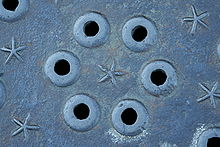Manhole cover







A manhole cover is a removable plate forming the lid over the opening of a manhole, to prevent someone from falling in and to keep unauthorized persons out.
Manhole covers usually weigh more than 100 pounds (roughly 50 kg), partly because the weight keeps them in place when traffic passes over them, and partly because they are often made out of cast iron, sometimes with infills of concrete. This makes them inexpensive and strong but heavy. They usually feature "pick holes", in which a hook handle is inserted to lift them. Specialized manhole hooks are manufactured for this purpose.
India has become the world leader in manufacturing manhole covers, driving many manufacturers in other countries out of business.[1] Its extremely low labor costs have overcome even the cost of shipping such heavy objects.
Although the covers are too large to be collectible, their ubiquity and the many patterns and descriptions printed on them has led some people to collect pictures of covers from around the world.
Despite their weight and cumbersome nature, manhole covers are sometimes stolen, usually for resale as scrap, particularly when metal prices rise.
Why are they generally round?
The question of why manhole covers are typically round, at least in the U.S., was made famous by Microsoft, and Tony Martinez when they began asking it as a job-interview question.[2] Originally meant as a psychological assessment of how one approaches a question with more than one "right" answer, the problem exerts a strange fascination on people, who seek to find alternate explanations, from the pragmatic and satirical to the philosophical. One practical answer being, "Manhole covers are round because manholes are round."[2]
Reasons for the shape include:
- A round manhole cover cannot fall through its circular opening, whereas a square manhole cover may fall in if it were inserted diagonally in the aperture (A Reuleaux triangle or other curve of constant width would also serve this purpose, but round covers are much easier to manufacture.)
- Round tubes are the strongest and most material-efficient shape against the compression of the earth around them, and so it is natural that the cover of a round tube assume a circular shape.
- The bearing surfaces of manhole frames and covers are machined to assure flatness and prevent them from becoming dislodged by traffic.
- Round castings are much easier to machine using horizontal boring mills.
- Circular covers do not need to be rotated to align them when covering a circular manhole.
- Human beings have a roughly circular cross-section.
- A round manhole cover can be more easily moved by being rolled.
- If an automobile rolls over a dislodged manhole of another shape, the sharp corners could puncture the automobile's tire, whereas a circle doesn't have corners.
- Tradition
- Aesthetics
Other manhole shapes can be found, usually squares or rectangles. Nashua, New Hampshire may be unique in the U.S. for having triangular manhole covers that point in the direction of the underlying flow. The city is phasing out the triangles, which were made by a local foundry, because they are not large enough to meet modern safety standards, and larger triangles cannot be found. [1]
The high price of iron recently has encouraged the recycling and theft of many iron objects including manhole covers,[3] telegraph posts, and railway rails.
Chinese government efforts to reduce manhole cover theft have reduced the annual theft of manhole covers in Beijing to 4000 in 2005 from 24,000 in 2004.[4]
Can a race car lift a manhole cover?
Modern racing cars create so much vacuum due to their aerodynamics that they can lift a manhole cover off the ground. During races on city streets, the manhole covers must therefore be welded down to prevent injury. In 1990, during the Group C World Sportscar Championship race in Montreal, racer Jesus Pareja's car struck a manhole cover that was lifted by the ground effect of the car he was following, causing his car to catch fire.[5]
The first man-made object in space?
An urban legend claims[citation needed] that a manhole cover was accidentally launched from its shaft during an underground nuclear test in the 1950s, at enough speed to attain earth orbit. The story is based on a real incident in August 27 1957 during the Operation Plumbbob nuclear tests, where a heavy steel plate cap was blasted off the test shaft at tremendous velocity, never to be seen again. It is not known if it actually left the atmosphere.
See also
References
- ^ Made in India, Little India
- ^ a b Poundstone, William (2003). How Would You Move Mount Fuji? Microsoft's Cult of the Puzzle – How the World's Smartest Company Selects the Most Creative Thinkers. Little, Brown. ISBN 0-316-91916-0.
- ^ Severely punish theft of manhole covers, Liu Shinan (China Daily) 2005-12-21
- ^ Rampant manhole theft in China, The Age, Feb 8, 2006
- ^ Classic Cars Race Results Database
Printed references:
- Melnick, Mimi (1994). Manhole Covers, MIT Press, USA. ISBN 0-262-13302-4
- Stuart, Diana (2003). Designs Underfoot: The Art of Manhole Covers in New York City, The Lyons Press, USA. ISBN 1-58574-639-8
External links
- Tekpool Discussion Forums for Manhole Covers The Famous Manhole Interview Question
- Rampant manhole theft in China, The Age, Feb 8, 2006
- Manhole Covers in Space – exhaustive article by Debbie Moorhouse
- The Pascal-B nuclear test
Collections of photos
- "Covers to Discover"
- ManHole.ca
- Photos of manhole covers around the world
- Drainspotting
- Manholes of Japan
- Photos of manhole covers from various cities
- 12 photos of manhole covers from Toulouse, France
- Photos of manhole covers from Romania and various foreign cities
- Manhole-covers.net Photos of manhole covers in France
